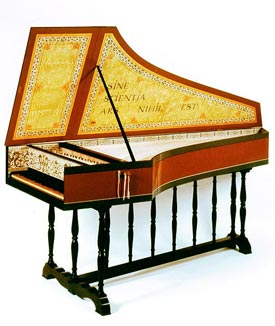Harpsichord
after Hans Moermans (1584)
original or extended range
(Both ranges available in kit form)
Harpsichord after Andreas Ruckers (1640)
original or extended range
(Available as custom instruments only)
 If
the harpsichord was born in Italy during the 15th century, it matured
into prominence as a solo instrument in Flanders between 1575 and 1650.
Flemish builders were not hesitant about using a more robust construction
than that previously used in traditional light Italian instruments.
The results of their innovations became the most widely emulated approach
to harpsichord building in the classical era. By 1625, Antwerp was the
acknowledged center for harpsichord production, a position it held until
the growth of the French school in the next century. Until the harpsichord
was discarded as a vehicle for musical expression, nearly all makers
claimed descent from the great workshops of Antwerp.
If
the harpsichord was born in Italy during the 15th century, it matured
into prominence as a solo instrument in Flanders between 1575 and 1650.
Flemish builders were not hesitant about using a more robust construction
than that previously used in traditional light Italian instruments.
The results of their innovations became the most widely emulated approach
to harpsichord building in the classical era. By 1625, Antwerp was the
acknowledged center for harpsichord production, a position it held until
the growth of the French school in the next century. Until the harpsichord
was discarded as a vehicle for musical expression, nearly all makers
claimed descent from the great workshops of Antwerp.
 The
Hubbard large Flemish single-manual harpsichord (above) is patterned
on an instrument built in Antwerp in 1584 by Hans Moermans. In its received
form it is disposed 1 x 8', 1 x 4, buff and posses the short-octave
range GG/BB-f''' (non-transposing). The sound of this form is
full and bright.
The
Hubbard large Flemish single-manual harpsichord (above) is patterned
on an instrument built in Antwerp in 1584 by Hans Moermans. In its received
form it is disposed 1 x 8', 1 x 4, buff and posses the short-octave
range GG/BB-f''' (non-transposing). The sound of this form is
full and bright.
Following
18th century French tradition, we have extended the 55-note range of
the original to 58 notes (GG-e''' chromatic) and added a French 18th
century scaling (left). Disposed 2 x 8' with buff stop, the resulting
instrument has a crisp, free-speaking tone capable of performing the
brilliant solo keyboard works of the 17th and 18th centuries as well
as concerti with baroque orchestra. It serves equally well as continuo
accompaniment in the chamber music literature of the period. Its most
practical feature, however, is its compact size which makes it a portable
companion for the touring professional.

Our
small Flemish single-manual harpsichord (right) is based on an instrument
made in Antwerp in 1640 by Andreas Ruckers. In its
original form had the short-octave range C/E-c'''. Its range
was extended sometime in the 18th century from 45 to 51 notes and we
have added one note for transposition. Disposed in either version 1
x 8', 1 x 4', buff stop, these instruments make a great deal of superior
sound, more than one would judge possible from their size. One hears
in them (and in the original-range Moermans) the magical tone quality
that clearly was a part of the mystique surrounding 16th century Flemish
harpsichords. They are offered decorated with reproduction block-printed
paper on the interior surfaces and painted on the outside.
Flemish
single-manual harpsichords - Custom
Instrument offering sheet
Kit
offering sheets
After
Moermans, 1584, original, received range
After
Moermans, à petit ravalement
Listen
to the small Flemish single...
You
can hear an excerpt from a demonstration
CD we have prepared for this instrument:
~
A Note About The Files ~
Not
all mp3 files are equal! The sound of a harpsichord is particularly
difficult to compress satisfactorily. The bit rate we have chosen
for these samples is the lowest that reproduces the original recording
with negligible loss. Download times will vary widely depending on
your setup and the quality of your connection. On a 28K Internet
connection, the shorter sound sample may take from about 5 to over
10 minutes to download. If you have a fast connection (T1, cable modem,
DSL) please try the long sample - you may expect download times substantially
under a minute.
~
Problems Playing the File ~
If you cannot play the file through your web browser, PC users
with the Microsoft browser can right click on the link, then choose
the "Save target" option to download the file, then use
an MP3 player (or a the Windows media player) to listen to it.
We now have available a demonstration
CD which demonstrates the different voices of these two designs
($10.00 ppd. in U.S.). Please - inquire via our
contact form.

